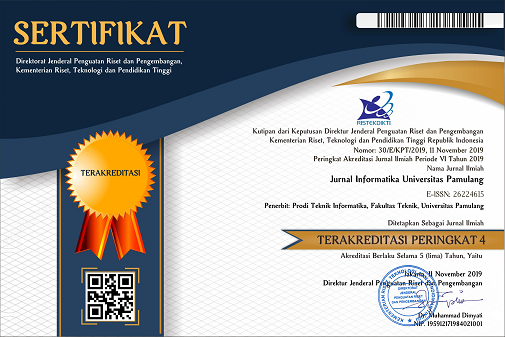Implementasi Deep Learning Menggunakan Metode CNN dan LSTM untuk Menentukan Berita Palsu dalam Bahasa Indonesia
DOI:
https://doi.org/10.32493/informatika.v5i4.6760Keywords:
Fake News, Indonesian Language, Deep Learning, CNN, LSTMAbstract
This research aims to implement deep learning techniques to determine fact and fake news in Indonesian language. The methods used are Convolutional Neural Network (CNN) and Long Short Term Memory (LSTM). The stages of the research consisted of collecting data, labeling data, preprocessing data, word embedding, splitting data, forming CNN and LSTM models, evaluating, testing new input data and comparing evaluations of the established CNN and LSTM models. The Data are collected from a fact and fake news provider site that is valid, namely TurnbackHoax.id. There are 1786 news used in this study, with 802 fact and 984 fake news. The results indicate that the CNN and LSTM methods were successfully applied to determine fact and fake news in Indonesian language properly. CNN has an accuracy test, precision and recall value of 0.88, while the LSTM model has an accuracy test and precision value of 0.84 and a recall of 0.83. In testing the new data input, all of the predictions obtained by CNN are correct, while the prediction results obtained by LSTM have 1 wrong prediction. Based on the evaluation results and the results of testing the new data input, the model produced by the CNN method is better than the model produced by the LSTM method.References
Ananth, S., Radha, D. K., Prema, S., D., & Nirajan, K. (2019). Fake News Detection using Convolution Neural Network in Deep Learning. International Journal Of Innovative Research In Computer And Communication Engineering, 7(1).
CNNIndonesia. (2018a, October 1). VIDEO: Warga Panik Akibat Hoaks Gempa-Tsunami di Sulbar. https://www.cnnindonesia.com/nasional/20181001165424-24-334695/video-warga-panik-akibat-hoaks-gempa-tsunami-di-sulbar
CNNIndonesia, R. (2018b, June 23). Upaya Negara Perangi Penyebaran Berita Palsu. https://www.cnnindonesia.com/teknologi/20180623085115-185-308291/upaya-negara-perangi-penyebaran-berita-palsu
Goodfellow, I., Bengio, Y., & Courville, A. (2016). Deep Learning. In MIT Press. MIT Press. https://www.deeplearningbook.org/
Haryalesmana, D. (2016). ID-Stopwords/id.stopwords.02.01.2016.txt at master · masdevid/ID-Stopwords · GitHub. https://github.com/masdevid/ID-stopwords/blob/master/id.stopwords.02.01.2016.txt
Hasil Survey Wabah HOAX Nasional 2019 | Website Masyarakat Telematika Indonesia. (2019). https://mastel.id/hasil-survey-wabah-hoax-nasional-2019/
Hossin, M., & Sulaiman, M. N. (2015). A Review on Evaluation Metrics for Data Classification Evaluations. International Journal of Data Mining & Knowledge Management Process. https://doi.org/10.5121/ijdkp.2015.5201
Kementerian Komunikasi dan Informatika. (2020, February 15). https://www.kominfo.go.id/content/detail/24415/hoaks-satu-warga-di-toraja-utara-terjangkit-virus-corona/0/laporan_isu_hoaks
Li, Y., & Yang, T. (2017). Word Embedding for Understanding Natural Language: A Survey (Vol. 26). https://doi.org/10.1007/978-3-319-53817-4
Mediani, M. (2017, August 28). Saracen: Bisnis Hoax Hancurkan Lawan Politik. https://www.cnnindonesia.com/nasional/20170828063335-32-237676/saracen-bisnis-hoax-hancurkan-lawan-politik
Putri, T. T. A., S, H. W., Sitepu, I. Y., Sihombing, M., & Silvi. (2019). Analysis and Detection of Hoax Contents in Indonesian News Based on Machine Learning. Journal Of Informatics Pelita Nusantara.
Rahutomo, F., Pratiwi, I. Y. R., & Ramadhani, D. M. (2019). Eksperimen Naïve Bayes Pada Deteksi Berita Hoax Berbahasa Indonesia. JURNAL PENELITIAN KOMUNIKASI DAN OPINI PUBLIK. https://doi.org/10.33299/jpkop.23.1.1805
Tentang Kami - TurnBackHoax. (2016). https://turnbackhoax.id/tentang-kami/
Verma, P., & Khandelwal, B. (2019). Word embeddings and its application in deep learning. International Journal of Innovative Technology and Exploring Engineering. https://doi.org/10.35940/ijitee.K1343.0981119
Zheng, A. (2015). Evaluating Machine Learning Models - O’Reilly Media. In Oreilly.
Downloads
Published
Issue
Section
License
Authors who publish with this journal agree to the following terms:
- Authors retain copyright and grant the journal right of first publication with the work simultaneously licensed under a Creative Commons Attribution-NonCommercial 4.0 International (CC BY-NC 4.0) that allows others to share the work with an acknowledgement of the work's authorship and initial publication in this journal.
- Authors are able to enter into separate, additional contractual arrangements for the non-exclusive distribution of the journal's published version of the work (e.g., post it to an institutional repository or publish it in a book), with an acknowledgement of its initial publication in this journal.
- Authors are permitted and encouraged to post their work online (e.g., in institutional repositories or on their website) prior to and during the submission process, as it can lead to productive exchanges, as well as earlier and greater citation of published work (See The Effect of Open Access).
Jurnal Informatika Universitas Pamulang have CC-BY-NC or an equivalent license as the optimal license for the publication, distribution, use, and reuse of scholarly work.
In developing strategy and setting priorities, Jurnal Informatika Universitas Pamulang recognize that free access is better than priced access, libre access is better than free access, and libre under CC-BY-NC or the equivalent is better than libre under more restrictive open licenses. We should achieve what we can when we can. We should not delay achieving free in order to achieve libre, and we should not stop with free when we can achieve libre.
Jurnal Informatika Universitas Pamulang is licensed under a Creative Commons Attribution-NonCommercial 4.0 International (CC BY-NC 4.0)
YOU ARE FREE TO:
- Share : copy and redistribute the material in any medium or format
- Adapt : remix, transform, and build upon the material for any purpose, even commercially.
- The licensor cannot revoke these freedoms as long as you follow the license terms





